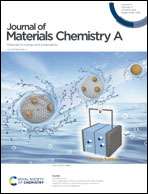Controllable transformation from 1D Co-MOF-74 to 3D CoCO3 and Co3O4 with ligand recovery and tunable morphologies: the assembly process and boosting VOC degradation†
Abstract
The controllable assembly of three-dimensional (3D) nanomaterials from a one-dimensional (1D) precursor has always been one of the difficulties in nanomaterial synthesis. Here, we use a gentle hydrolysis of 1D metal–organic frameworks (MOFs) to prepare 3D CoCO3, with full and convenient recovery of costly organic ligands. For the first time, 1D nanowires of Co-MOF-74 were transformed into CoCO3 with different 3D morphologies by introducing different modulators of urea or hexamethylenediamine (HMT). The formation mechanism (using urea as a modulator) has been elucidated and has revealed a conversion process from 1D nanowires of Co-MOF-74, subsequently to 1D rod-like stacked 3D Co-MOF-74 nanospheres through aggregate assembly, and then to 3D hydrangea like CoCO3-H. After calcination, it was found that the obtained 3D Co3O4 catalyst derived from 3D CoCO3 exhibited significantly enhanced catalytic performance for VOC degradation compared to 1D Co3O4 directly calcined from Co-MOF-74. In addition, the morphology and the catalytic performance of the catalysts prepared with the recycled ligands were consistent with those of catalysts made from fresh ligands.



 Please wait while we load your content...
Please wait while we load your content...